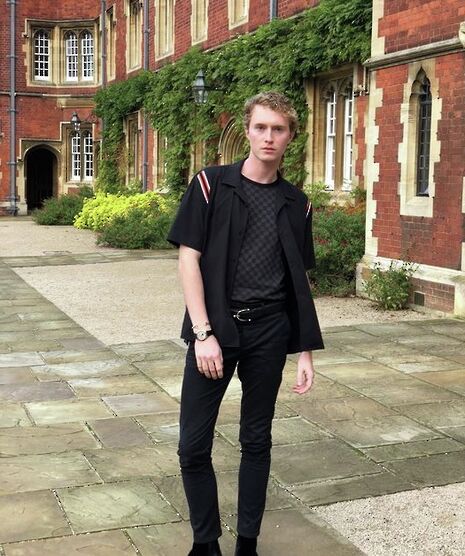Gender-fluid fashion in a style evolution
In her last column, Sophie Weinmann talks to New York City native PhD student Axel Gertz about his journey to find his personal fashion identity

After a term of exploring Cambridge fashion and talking to students across colleges and subjects about their personal style, my final column led me to Jesus where I spoke to a PhD student from New York, Axel Gertz, about his style evolution, gender-fluid clothing and the infamous ZiGi Vogue article.
When beginning to describe his personal style, Axel notes that while he always enjoyed fashion, he didn’t necessarily consider himself a fashionable person a few years ago. He recalls looking in the mirror and feeling like his style then, which he describes as very preppy with a lot of Brooks Brothers jackets and Vineyard Vines jeans, didn’t truly express who he was as a person.
“I made it a piece that I rocked and it didn't matter if it came from menswear or womenswear.”
“Everyone in my town dressed this way and there’s nothing wrong with that, I don’t have anything against preppy clothing, but I just looked at myself and felt like a total conformist. I didn’t feel like I was authentically myself, I felt like I was just trying to fit a mould that I didn’t really want to be a part of. I realised I wanted to use fashion to express a little bit more of a creative side of me, so I began to think ‘How do you want to present yourself? How do you want your brand to be seen?’ and totally revamped the closet – and I'm really happy because now every day I wake up and I get to have a little creative moment before I go out to start my day,” he confessed.
Describing his style as “very New York City, urban inspired”, Axel explains that since making those initial changes to the way he approaches fashion, he has been very conscious about the things he buys and how they fit into his general aesthetic. The mindfulness and deliberation in his approach to fashion shines through as Axel tells me about one of his favourite pieces – a green leather biker jacket, which he first spotted in the womenswear section of ZARA when he was helping his sister shop and revamp her style before she left for college. After initially picking it out and planning outfits around it for her, he went back later that day to try it on himself. Having fallen in love with the piece, he brought it to New York Fashion Week, where he was walking in a show that same day.

He recalls, “I got streetstyled in the jacket and the photo turned out great, and I was with a few other models that didn’t really know me and I didn’t really know them but that jacket, it made me feel invincible. And the reason why that was so important was because the jacket was womenswear, it was labelled womenswear and I made it menswear – but I don’t even care that I made it menswear. I made it a piece that I rocked and it didn't matter if it came from menswear or womenswear. Since that jacket I've gone into the womenswear department of a lot different stores many times to find unique pieces.”
We then delved deeper into the topic of gender-fluid clothing, a topic that receives frequent media attention, especially when celebrities like Jaden Smith, Jonathan van Ness, or Amanda Stenberg refuse to conform to gendered clothing norms. While Axel highlights Jaden Smith as someone who does a lot for the non-binary aspect of clothing, he is more hesitant about the way in which celebrities may use the debates around gender norms in the fashion industry as a bid for publicity.
“I think a lot of the times, quite notoriously the Gigi Hadid and Zayn Malik Vogue article, it was all about them swapping clothes as a cis-het couple; it seems very shallow. The conversation that Jaden started by being in the womenswear Louis Vuitton campaign is much more meaningful and deep, I think. That being said, at the end of they day, they both started a conversation.”
 Comment / Plastic pubs: the problem with Cambridge alehouses 5 January 2026
Comment / Plastic pubs: the problem with Cambridge alehouses 5 January 2026 News / Cambridge businesses concerned infrastructure delays will hurt growth5 January 2026
News / Cambridge businesses concerned infrastructure delays will hurt growth5 January 2026 News / New movement ‘Cambridge is Chopped’ launched to fight against hate crime7 January 2026
News / New movement ‘Cambridge is Chopped’ launched to fight against hate crime7 January 2026 News / AstraZeneca sues for £32 million over faulty construction at Cambridge Campus31 December 2025
News / AstraZeneca sues for £32 million over faulty construction at Cambridge Campus31 December 2025 Interviews / You don’t need to peak at Cambridge, says Robin Harding31 December 2025
Interviews / You don’t need to peak at Cambridge, says Robin Harding31 December 2025










